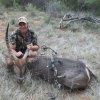RockyMtnMT
Official LRH Sponsor
Awesome! Pass through at that distance means it maintained its weight and a single structure. Awesome vital damage too... Was the kill quick? With vital damage like that it must have been a violent stop.
I have notice on many occasions that the inclination to fragment is not necessarily due to bone impact. I have had shots pass through between the ribs with PMP ammo here (similar to Hornday Interlocks in toughness and structure) and they have broken apart and deconstructed.
I have also seen quite a few failures on monolythics in respect of expansion... You can't afford narrow wound channels on titans like gemsbuck, eland, kudu and bluewildebeest (even the zebra is a machine with a sub-optimal wound channel).
I shot a zebra stallion a few years ago at around 230 yards in Ograbies (Kalahari) with a 300 Winchester Magnum and the monolythic bullet of choice entered on the shoulder, glanced off of the shoulder bone, turned to run along the ribcage (after nicking a lung and sending bone fragments into the chest cavity) toward the rear-end, exited from the back rib (tearing a massive hole in the rumen causing stomach contents to fall from the side) re-entered at the hip and exited out of the rear-end with a massive jagged wound...
Sub-optimal penetration is also an issue at longer distances on larger game (and bullet fragmentation), which is what I fear when using match-style bullets (even in heavier weights)... The shotgun effect may be problematic when hitting a rib squarely from 400-500 yards as the reduction in energy may cause these tiny bullet fragments to cause sub-optimal wounding to the vital organs and lower velocity may reduce the wounding and hydrostatic shock to have very little effect.
I personally choose the Hornady Interbond and Sierra Gameking as my bullets of choice and have taken over 30 heads of game with both bullets (mostly Gameking).
The rest of the game that I have hunted have been with PMP ProAmm or standard factory ammo.
I think this may have been due to not enough stability for the mono. The mono bullets are long for their weight or light for their length. How ever you want to look at it. Either way they require more twist for good stability in terminal ballistics. If they are low on sg then they will tend to tumble and not stay on the intended path. Also may not open as they should if the point deflects at all.
This is why we have been so diligent about the required minimum twist for our bullets. Marginal stability will still shoot very accurately but cause problems in terminal performance. I thought that I understood stability until we did low vel impact testing. Learned a lot. Fortunately we did our learning on test media. Hollow point bullets need hydraulics to make them open. This goes for tipped bullets as well. They are hollow point too, they just have a piece of plastic stuck in the hole. Sometimes the tip inserted into the hole can impede the expansion if the hydraulics can not get into the cavity.
Our North American game animals are not as hard to kill as yours, so our guys don't see the need for what you are talking about. Keep up the good conversation.
Steve







